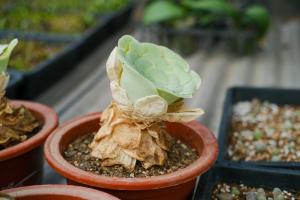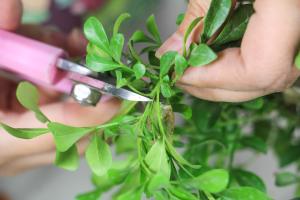Introduction
Sago palm trees, also known as Cycas revoluta, are popular ornamental plants that can add a tropical touch to your garden or landscape. These plants are native to Southern Japan, but they can grow in many regions with warm climates. If you want to learn how to plant and care for a sago palm tree in the ground, this guide will give you step-by-step instructions.
Choosing the Right Spot
To grow a healthy sago palm tree, you must select the right location. These plants thrive in full sun or partial shade, so choose a spot that receives ample sunlight but is not exposed to harsh midday heat. Also, sago palm trees prefer well-drained soil with a pH range of 5.5 to 7.5. Avoid planting your tree near high-traffic areas or places with strong winds, as this can damage the foliage and slow its growth.
Preparing the Soil
Before planting a sago palm tree in the ground, you need to prepare the soil. This involves removing any weeds or grass from the planting area and loosening the soil to a depth of about 12 inches. You can use a shovel, hoe, or tiller to achieve this. Then, add compost or organic matter to the soil to improve its drainage, water-holding capacity, and nutrient content. Mix the compost with the soil to a depth of about 6 inches and make sure there are no clumps or air pockets.
Planting the Sago Palm Tree
Now that you have prepared the soil, you can plant the sago palm tree in the ground. First, dig a hole that is twice the size of the plant's root ball or container. Then, carefully remove the plant from its container and loosen the roots by gently teasing them with your fingers. Place the root ball in the center of the hole and fill the hole with soil until it is level with the surrounding ground. Water the plant thoroughly to settle the soil around the roots and remove any air pockets. Also, create a 3-inch high ring of soil around the plant's base to create a water-retaining saucer.
Caring for the Sago Palm Tree
After planting the sago palm tree, you need to care for it properly to ensure its survival and growth. Here are some tips to follow:
Watering: Sago palm trees require regular watering, but they can tolerate drought conditions. Water the plant deeply once a week or when the soil feels dry to the touch. Avoid overwatering or allowing the soil to become waterlogged, as this can rot the roots.
Fertilizing: Sago palm trees do not require frequent fertilization. Apply a slow-release or organic fertilizer once in the spring and once in the fall, following the manufacturer's instructions. Avoid using high-nitrogen fertilizers, as this can damage the plant's roots and leaves.
Pruning: Sago palm trees do not require frequent pruning, but you can remove any yellow or brown fronds or damaged branches using pruning shears. Wear gloves and eye protection when pruning, as the fronds can be sharp and create debris.
Pest and Disease Control: Sago palm trees can be infested by mealybugs, scale insects, or spider mites, which can weaken or kill the plant. To control these pests, apply an insecticidal soap or oil according to the label directions. Also, make sure the plant has good air circulation and sunlight to prevent fungal infections or root rot.
Conclusion
Planting a sago palm tree in the ground can be a fulfilling and rewarding experience. By following these simple steps and caring for the plant properly, you can enjoy its beauty and elegance for years to come. Remember to choose the right spot, prepare the soil, plant the tree carefully, and maintain it with regular watering, fertilizing, pruning, and pest control. Good luck and happy planting!

 how many times do yo...
how many times do yo... how many planted tre...
how many planted tre... how many pine trees ...
how many pine trees ... how many pecan trees...
how many pecan trees... how many plants comp...
how many plants comp... how many plants can ...
how many plants can ... how many plants and ...
how many plants and ... how many pepper plan...
how many pepper plan...































